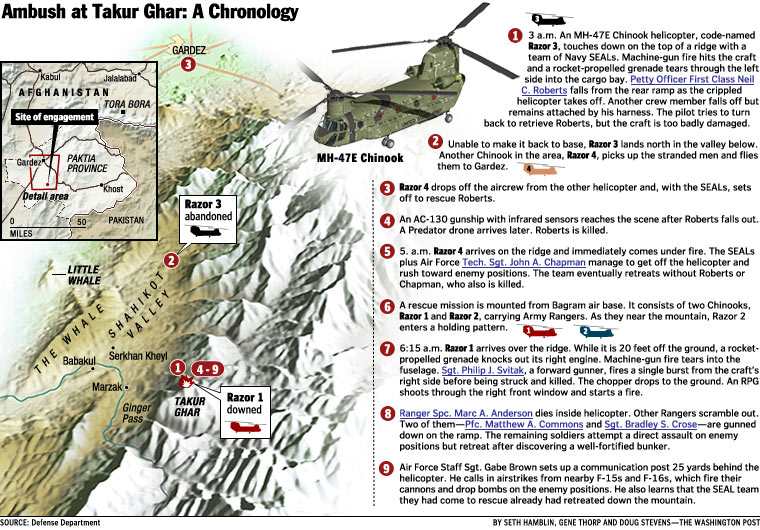USNewsLink™ © 2003 |
| READ PREVIOUS ARTICLES BY JUDITH HANEY |
OUR PICK FOR BIGGEST MEATHEAD OF 2002 by Judith
Haney
ADDITIONAL READING ABOUT THIS MISSION: Ambush at Takur
Ghar: Part I A Wintry Ordeal at 10,000 Feet: Part II Equipment Failures Hindered Battle The war commander, Army Gen. Tommy Franks, attributed the problems to the harsh weather and equipment failures, such as broken radios and shot-up helicopters, rather than to human error. In a leadup to Memorial Day, he praised the bravery of the troops and the success, though costly, of the operation in recounting the battle on the frigid mountaintop against dug-in al-Qaida fighters. A commando who fell out of a helicopter and six soldiers who tried to rescue him were killed. "That battle showed heroism," Franks said. "It showed fog, uncertainty, it showed friction, elements common to every war I think we've fought." "In the end the bravery and the audacity and certainly the tenacity of the people involved in that operation carried the day." During the battle, in March in an area of eastern Afghanistan the locals call Takur Ghar, U.S. commanders watched helplessly as a Predator drone relayed live video of some of the fighting. The operation was hurt by communications problems, from a reconnaissance flight that failed to detect al-Qaida forces lying in wait to the difficulties that troops on the ground and in helicopters had in raising their commanders and nearby warplane pilots. Franks indicated troops in the heat of the fight might have used a wrong radio frequency. But he said no changes in command arrangements between regular and special forces were made as a result of a Pentagon review. He said of the people on the scene that day: "I think their judgments were good." Nor did he think it was extraordinary that equipment would malfunction given the circumstances. "In the middle of a firefight, things will get shot up," he said. Defense Secretary Donald H. Rumsfeld was briefed on the review's findings on Thursday. "As in most human endeavors, plans are never executed exactly the way they're developed," Rumsfeld said. The battle was part of Operation Anaconda, a U.S.-led effort to encircle and eliminate a large number of al-Qaida and Taliban fighters in the mountains south of Gardez. It began early in the morning of March 4, when a CH-47 Chinook helicopter tried to drop a team of Navy SEAL commandos near the top of a mountain. There were heavily armed al-Qaida fighters there, and they shot at the chopper with machine guns and rocket-propelled grenades. The helicopter was hit, and as it lurched away to safety, Navy Petty Officer First Class Neil Roberts tumbled out the rear door. Roberts survived the fall, but was eventually surrounded and killed by the al-Qaida fighters. Six others were killed as two other Chinooks dropped in teams to rescue Roberts or recover his body. One man, Air Force Tech. Sgt. John Chapman, was with Roberts' group of SEALs. They had boarded another Chinook and returned to the mountain to get Roberts but also came under fire and fell back, farther down the mountain, before the third Chinook arrived. Five of the dead were from that last team, Army Rangers and Air Force commandos whose Chinook landed after daybreak at the spot where Roberts fell out of his helicopter. The third Chinook also came under heavy fire and was disabled; it was believed that the four Rangers killed were shot either inside the helicopter or as they were trying to leave it. The surviving members of the Ranger unit battled the al-Qaida forces for hours before being evacuated. Equipment Faulted in 'Anaconda' Losses LA Times, May 24, 2002 The deadliest firefight for the United States in the Afghan war-- a mountain battle that killed seven Americans-- was beset by communications problems, the Pentagon said today. The operation was hurt by communications problems, from a reconnaissance flight that failed to detect Al Qaeda forces lying in wait to the difficulties that troops on the ground and in helicopters had in raising their commanders and nearby warplane pilots. Franks indicated troops in the heat of the fight might have used a wrong radio frequency |



